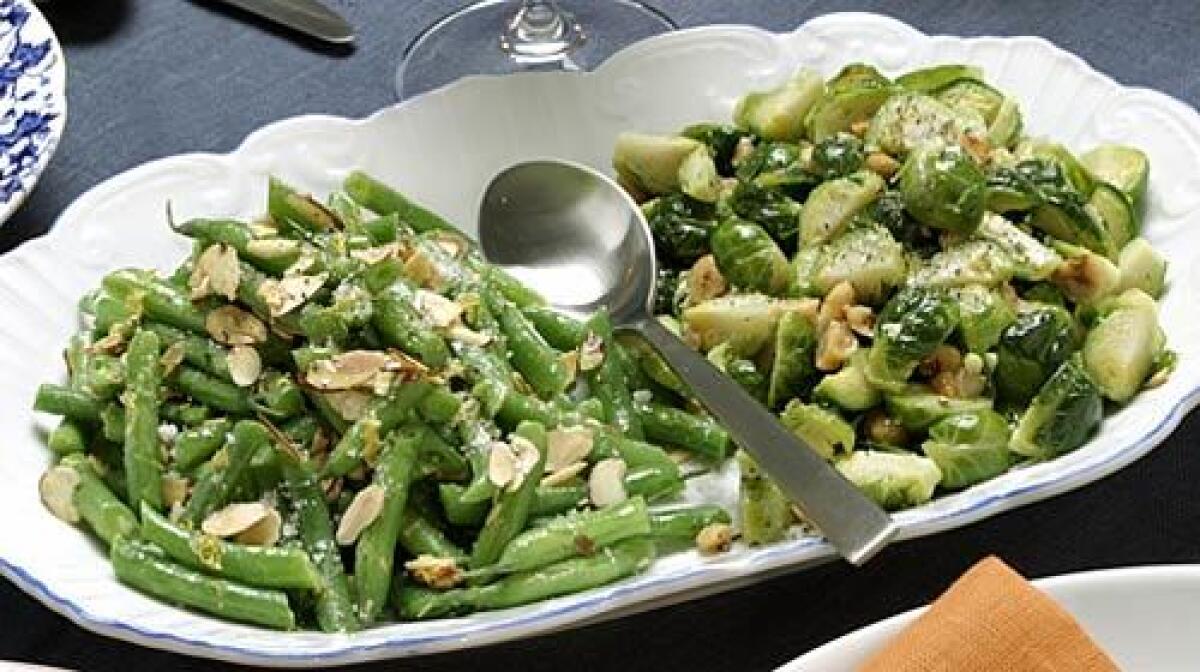Really, no need to panic

- Share via
No one talks about them. No one oohs and aahs when they come to the table. There’s no glory in their preparation. They’re blamed -- unjustly! -- for being a last-minute pain in the neck.
They’re the Thanksgiving vegetables.
Are they obligatory? Yes. Must they be a holiday bummer? A thousand times no.
In a menu carved in stone by Pilgrims real or imagined, the vegetable dish is one place for the cook’s self-expression to shine. It’s a spot of brightness in an otherwise beige feast. Treat a vegetable right, and it will sing.
It all starts the day before (yes, that would be today!) with a mountain of vegetables and a big pot of boiling, salted water. That’s right, far from being a last-minute drag, the Thanksgiving vegetable, counterintuitive as it may seem, is actually best prepared ahead. Well, mostly ahead.
The beautiful thing, when it comes to most green vegetables, is that you can trim and cut them, blanch them, and hold them till just before the meal, at which point you can dress them up in no time flat. That final touch might be Meyer lemon zest and toasted almonds. It could be sliced shallots, with a sherry vinegar zing. Maybe top them with some crunchy, toasted hazelnuts, and give them a drizzle of rich hazelnut oil. Or maybe you have your own ideas. How do you decide? Think about the rest of your menu, and try to imagine what kind of flavor you want. Something bright? Think lemon or vinegar. Something rich? Think butter or chopped, toasted nuts.
Choose a green vegetable, whatever strikes your fancy. Green beans, particularly succulent, flavorful Blue Lakes, are terrific right now. Roma beans swing too. Feel like going elegant and French? Go with haricots verts.
Or maybe you’ve picked up some gorgeous Brussels sprouts on the stalk. Broccoli always rocks on Thanksgiving. Whatever the vegetable, the method will be the same: a quick blanching today, and last-minute finishing in the pan tomorrow.
Knowing how to cook well is largely a matter of knowing how to taste -- that’s how you know when a dish is perfect and in balance. When vegetables are fresh and cooked just right, it all comes down to the seasoning. And the only way to know whether they’re seasoned right is to slow down, focus and really taste them, every step of the way.
There’s nothing better than a simple dish of super-fresh string beans, perfectly cooked, slicked with a little great-quality olive oil, a touch of lemon and good salt and pepper. Too much olive oil? They’re oily. Not enough salt? They’re dull.
Before you even start, you have to talk to the vegetables. Stuffing is forgiving and always fabulous. But the vegetables require some face time. Talk to them as they’re boiling, watching them so they don’t overcook. Prepare enough string beans, and you can tell as you’re watching one boil that it’s done. You’ll have another chat with them Thursday, but it’ll have to be brief, because it’s Thanksgiving Day.
So some time today, trim those vegetables, and cut them the way you like them. Blue Lakes or Roma beans do well cut into 2-inch lengths; Brussels sprouts are lovely quartered vertically. Drop them in boiling, salted water, and watch them closely. When they’re just slightly undercooked, they’re done. Now, quick, drain them and shock them in a big bowl of ice water. Drain again, pat them dry and keep them refrigerated until tomorrow. If you’re adding vegetables such as sliced shallots or diced peppers, you can do those ahead too.
Just before serving, heat butter or olive oil in a saute pan, add the blanched vegetables and give them a few tosses, letting them heat through. Taste one. Is it not cooked quite enough? Keep warming a minute or two more. Use butter if you want to go for richer flavor, olive oil if you prefer more Mediterranean.
Take the vegetables off the heat, and add the zest or shallots or nuts -- or just start riffing. A little more great-quality oil? Some bright acid, lemon juice or vinegar? A few chopped, sauteed mushrooms?
Salt and pepper are the final touches. It may sound silly, but the way you season that vegetable can make or break it. Use the best salt you have -- Maldon sea salt, for example, or fleur de sel. Both have terrific texture (I like to crush the crystals a bit between my fingers as I sprinkle on the salt). Then, a generous grinding of fresh black pepper. Or maybe you prefer red pepper flakes.
Now taste. Are they perfect? Are they amazing? They should be. If not, slow down and really pay attention. Have a chat with the Brussels sprouts. What do they want, more acid? A touch more salt? Stare them down, tasting, until they tell you.
And when you come to an agreement, head to the table.
More to Read
Eat your way across L.A.
Get our weekly Tasting Notes newsletter for reviews, news and more.
You may occasionally receive promotional content from the Los Angeles Times.










